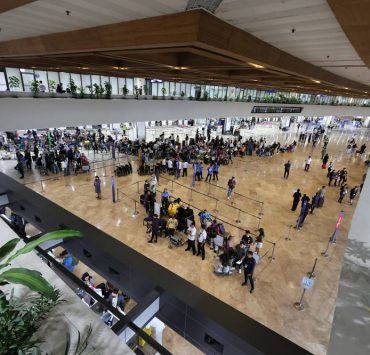Undoing damage to a PH treasure
Filipinos were rightly and justifiably outraged by aerial images of a private resort nestled at the foot of the Chocolate Hills of Bohol, complete with a swimming pool, water slides, and cottages that stood out like plastic monstrosities on one of the Philippines’ remaining natural treasures.
Within hours of being posted on social media, the videos featuring the tourist offerings of Captain’s Peak Garden and Resort in Sagbayan town ignited a viral uproar.
And for good reason.
“It is infuriating and heartbreaking,” said Sen. Nancy Binay, chair of the Senate tourism committee, putting into words the atrocity of a geographic wonder defaced by such a gaudy development and turned into yet another eyesore.
The country is already replete with examples of commercial encroachment on important cultural landmarks, among them the wind energy farm in Masungi Georeserve in Rizal, the condominium tower at the back of Manila’s Luneta Park, and those reclamation projects ruining the Manila Bay sunset, all of which have triggered backlash in one form or another.
A source of pride
But there’s something particularly saddening about the disfigurement of the Chocolate Hills, which, like the similarly threatened Banaue Rice Terraces and Mayon Volcano of Albay, are revered by Filipinos not only for their beauty but the myths and legends inspired by them.
As the first Philippine site to be recognized as a United Nations Educational, Scientific, and Cultural Organization Global Geopark, it’s no wonder that the Chocolate Hills are a source of pride and protectiveness among our people. They are actually 1,776 limestone mounds dotting Bohol’s interior plains, so named because they turn a chocolate brown in color during the dry season.
In 1997, then President Fidel V. Ramos, through Presidential Decree No. 1037, declared the Chocolate Hills straddling the towns of Carmen, Bilar, Batuan, Sagbayan, Sierra Bullones, and Valencia as a Natural Monument, ensuring their protection. The famed hills are also protected under the Expanded National Integrated Areas Protected System Act.
But the rights of landowners of titled properties within the protected site are recognized by law provided the titles were issued prior to its passage, including the 10,000 square-meter property in Barangay Canmano on which Captain’s Peak stands.
‘Endless’ requirements
Still, any development in these areas is subject to conditions for the issuance of an environmental compliance certificate (ECC), which the Bohol resort, to date, has failed to secure.
Resort manager Julieta Sablas complained to the Inquirer last week about the “endless” requirements of the Department of Environment and Natural Resources (DENR) for an ECC.
“Every time we accomplish a set of requirements, there’s always a new set. They won’t give it to us all at once,” said Sablas, sister of the owner Edgar Button, who bought the land in 2005.
Yet, despite having no ECC, she claimed that the resort received approval from DENR’s Protected Area Management Board to build facilities in 2018, and a business permit from the Sagbayan local government in 2019. The 3-hectare resort began full operation in 2022 and has since served more than 3,000 guests.
Finger-pointing
Right on cue, the finger-pointing began.
The DENR was quick to note that it issued a temporary closure order (TCO) on Captain’s Peak as far back as September last year, on top of a notice of violation on Jan. 22 for operating without an ECC.
But Sagbayan officials said the town never received any such order. Later, the municipality led by Sagbayan Mayor Restituto Suarez III revoked the resort’s business permit.
Bohol Gov. Aris Aumentado, on the other hand, said the problem was already there before he took office and pledged to launch a new investigation.
The Department of Tourism (DOT) said the resort was not an accredited tourism establishment, while the Department of the Interior and Local Government (DILG) vowed to look into lapses by LGUs and demanded an explanation.
On March 13, Captain’s Peak announced its temporary closure while appealing the TCO.
More hideous developments
So, who is responsible, then?
With nobody taking accountability, it is incumbent upon the DENR, DILG, and DOT to work together to begin the complicated process of undoing the damage that has been done to the site, including the filing of charges against responsible individuals, the preservation of untouched areas, and the demolition of all illegal structures there.
Beyond that, an investigation must determine which other Bohol developments, commercial and residential, are breaking the law. An Inquirer report in September last year noted that at least one other resort was flagged by environmentalists for illegal structures built near the Chocolate Hills.
Who knows how many more hideous developments are hiding in plain sight within our so-called protected areas while public officials turn a blind eye? What’s next—a subdivision right on top of the Chocolate Hills?
















